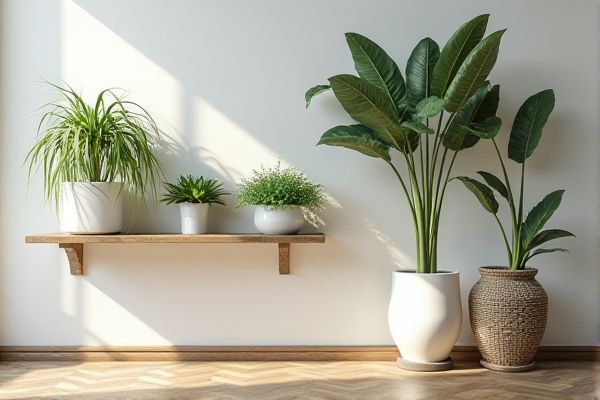
Wall-mounted planters save space and add vertical greenery, perfect for small areas, while freestanding planters offer mobility and can be rearranged to suit your garden layout. Explore the rest of this article to discover which option best suits your needs and enhances your outdoor space.
Table of Comparison
| Feature | Wall-Mounted Planter | Freestanding Planter |
|---|---|---|
| Installation | Requires wall mounting; screws or brackets needed | No installation; easy to move |
| Space Efficiency | Maximizes vertical space, ideal for small areas | Occupies floor space; needs sufficient ground area |
| Mobility | Fixed position; not easily relocated | Highly portable; easy to rearrange |
| Design Options | Sleek, modern aesthetic; integrates with walls | Varied styles; traditional to contemporary |
| Weight Capacity | Limited by wall strength and mounting hardware | Supports heavier plants or multiple pots |
| Drainage | Requires proper wall protection and drainage setup | Often has built-in drainage or stands with trays |
| Maintenance | More challenging to water and maintain | Easy access for watering and upkeep |
| Best For | Small spaces, vertical gardens, decorative displays | Large plants, flexible arrangement, garden portability |
Introduction to Wall-Mounted vs Freestanding Planters
Wall-mounted planters save space by attaching directly to vertical surfaces, making them ideal for small balconies or indoor gardens. Freestanding planters offer flexibility in placement and often accommodate larger plants or arrangements, enhancing outdoor patios or garden paths. Choosing the right option depends on your available space and design preferences to maximize both functionality and aesthetics.
Aesthetic Appeal: Space Utilization and Design
Wall-mounted planters enhance aesthetic appeal by creating vertical gardens that save floor space, making them ideal for small areas or minimalist designs. Freestanding planters offer versatile placement and sculptural presence, allowing for dynamic arrangement and focal points within larger spaces. Your choice depends on whether you prioritize maximizing space utilization with sleek, vertical greenery or prefer flexible, eye-catching plant displays.
Installation and Setup Differences
Wall-mounted planters require secure anchoring into walls using brackets or screws, making professional installation preferable for stability and safety, especially on drywall or brick surfaces. Freestanding planters offer simpler setup with no mounting needed; you can place or move them anywhere, requiring only level surfaces for balance and drainage considerations. Your choice influences ease of installation, with wall-mounted options consuming vertical space and freestanding models providing flexible positioning.
Plant Variety Suitability
Wall-mounted planters are ideal for small, trailing, or compact plants like succulents, herbs, and ferns, maximizing vertical space without floor clutter. Freestanding planters accommodate larger, bushier plants or those with extensive root systems, such as shrubs or small trees, offering more soil volume for optimal growth. Choosing the right planter based on plant variety suitability ensures Your greenery thrives and enhances your living space effectively.
Maintenance and Accessibility
Wall-mounted planters require less floor space and are easier to access for watering and pruning, making maintenance simpler in small areas. Freestanding planters offer greater flexibility in placement and can be moved outdoors for seasonal care, but may demand more effort to reach all sides during maintenance. Both types benefit from regular inspection, but wall-mounted options often allow quicker, more ergonomic access, reducing strain during plant care.
Indoor vs Outdoor Applications
Wall-mounted planters save space and are ideal for indoor applications where vertical gardening enhances room aesthetics, while freestanding planters offer flexibility and are better suited for outdoor use due to their mobility and larger size. Your choice depends on the available area and exposure to sunlight, as wall-mounted options often need sturdy walls and proper drainage, unlike freestanding planters that can be moved to optimize light and weather conditions. Selecting the right planter type ensures healthy plant growth and complements the intended indoor or outdoor environment.
Durability and Material Considerations
Wall-mounted planters typically feature durable materials like stainless steel or treated wood to withstand outdoor elements and weight stress on vertical surfaces. Freestanding planters often utilize heavier materials such as terracotta, concrete, or fiberglass, providing stability and resistance to wind and tipping. Choosing UV-resistant coatings and water drainage systems enhances longevity for both planter types in various weather conditions.
Cost Comparison and Budgeting
Wall-mounted planters generally cost less initially due to their compact design and lower material requirements compared to freestanding planters, which often demand more substantial construction and higher-quality materials for stability. Budgeting for a wall-mounted option can save space and reduce expenses on additional supports or large containers, making it ideal for smaller areas or limited budgets. You should also consider installation costs, as wall-mounted planters may require more precise mounting hardware, whereas freestanding planters offer easier placement but might need more soil and accessories, affecting overall spending.
Flexibility and Relocation Options
Wall-mounted planters offer limited flexibility due to their fixed installation on walls, making relocation challenging without potential damage or effort. Freestanding planters provide greater mobility, allowing easy movement to optimize sunlight exposure and accommodate seasonal changes. Their portability supports dynamic garden layouts and interior design adjustments based on evolving needs.
Choosing the Right Planter for Your Space
Wall-mounted planters maximize vertical space and are ideal for small apartments or rooms with limited floor area, offering a sleek, modern aesthetic while saving space. Freestanding planters provide greater flexibility in arrangement and can accommodate larger plants, making them suitable for patios, gardens, or spacious interiors. Selecting between the two depends on available space, plant size, and design preference to enhance both functionality and visual appeal.
 homyna.com
homyna.com